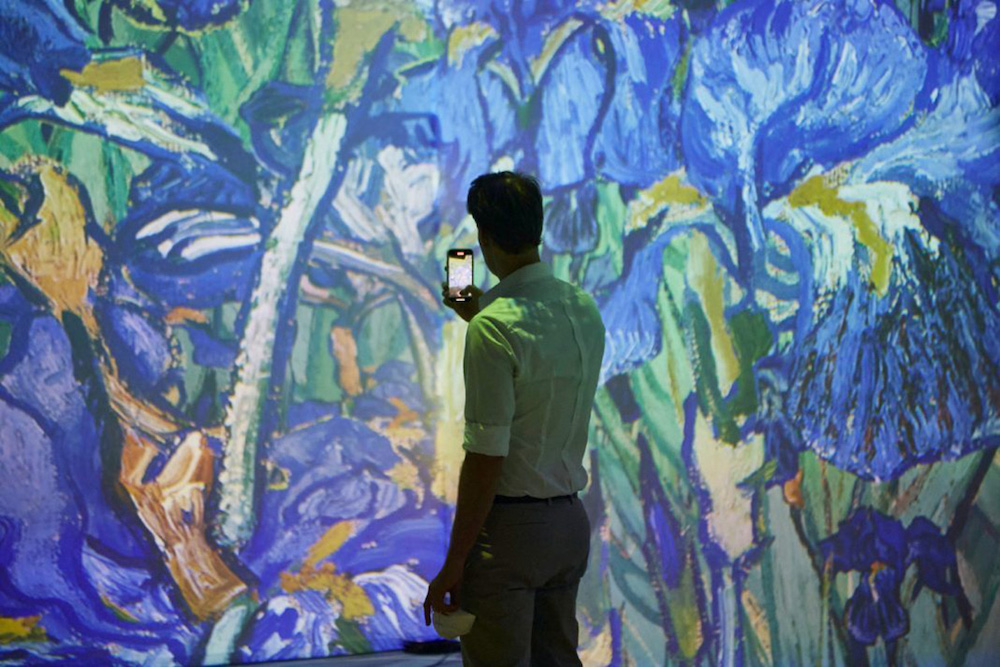With the current exponential rise in digital, AI-generated art and blockchain verifiable provenance, has the need for showing an original piece of art lost allure? Akin to a natural history museum showing a dinosaur skeleton that is 99% reproduction and 1% actual specimen or to a Vegas magician cutting the beautiful assistant in half six times a week, does it matter whether what we see is simply a beautiful illusion? Are we as art viewers more interested in the spectacle now? As handmade art goes the way of the dodo and is replaced with animatronics and videos of art, for the sake of all future generations I implore we ask: What is art and what is smoke and mirrors made for mass consumption?
Projecting Old Masters work on warehouse walls is all the rage, but as an appreciator of the of the artist’s hand—I struggle to see the allure. This generation of youth (my daughter included) will grow up thinking that van Gogh was actually a video artist and that Starry Night (her favorite painting) is 20 feet tall. What is lost here? Some would argue nothing—that rather mass exposure to the end consumer is gained. Aha, there in lies the issue—consumer vs. appreciator.
How could one argue that seeing a projection of art in any way parallels the experience of being in the presence of the most celebrated paintings the world has seen. I have taken the Harvard Google-earthesque 3D tour of the Great Pyramid on my laptop, but it is a far cry from traveling across the globe and experiencing the claustrophobic descent to the Queen’s chamber that a real exploration would provide.
Within the context of art—understanding the scale, the color, the frozen in time brush stroke/texture imbued by the artist’s hand—the je ne sais quoi quality that makes epic art epic can never be replaced by moving pixels or altered-reality. I will debate this point with anyone—that has never stood in front of a Rothko—and wants to take the side of the AI (trust me, they will become sentient). But at that point they may actually make good art!
Few institutions can take out a loan to exhibit a noted work of van Gogh, but droves of entrepreneurs/opportunists are now renting projectors, leasing abandoned big-box retail stores and shining images of appropriated non-copyrighted art on the walls for a mere $50 entry fee. As we think about intellectual property and public domain free usage for historic art, the commerce aspect begins to change how I read this story. All you need to do is pay a licensing fee to a photographer for their high-res images of those beautiful sunflowers and you are the new hot-ticket immersive experience.
On the opposite end of the spectrum from the digital exhibiting of Old Master works is the most contemporary of trends—the exhibiting of multi-million-dollar NFTs (which really boil down to a JPEG image whose provenance is verified on one of a multitude of blockchains.) What many don’t understand is that when an NFT is shown, the actual NFT is not really shown. There is no formal loan, no actual transfer of the art to the museum. Typically it is a simple JPEG that is shown, not the “actual piece of art.” Copy/paste. Does this matter? Does anyone care in the way I care about Vincent, that we are only seeing a reproduction.
Back to van Gogh for a thought-exercise relating to the NFT copy/paste. If rather than seeing a digital reproduction of a self-portrait—ear bandaged, staring eerily off canvas—we were actually viewing a painting that looked identical but we knew was a forgery of the iconic original. How would you feel knowing that the canvas was not painted by Vincent’s hand while in a cold damp room in Arles. Any difference there? I would still care, but I am a cynical viewer of art. To me the unseen affirmations that come with actual art matter. Why judge on simple aesthetics alone, be romantic, be critical, be poetic—the back story does fucking matter, the painting that was painted over by the masterpiece is still under there. We all came from somewhere, embrace your provenance. If we do not force this issue to the forefront, if we do not address that reproductions of art are not art, it will be lost on our children.
All we will be left with are van Gogh Museums in every major city, not one with an actual painting hung on the wall. But hey, plenty of projector technicians will have job security.


